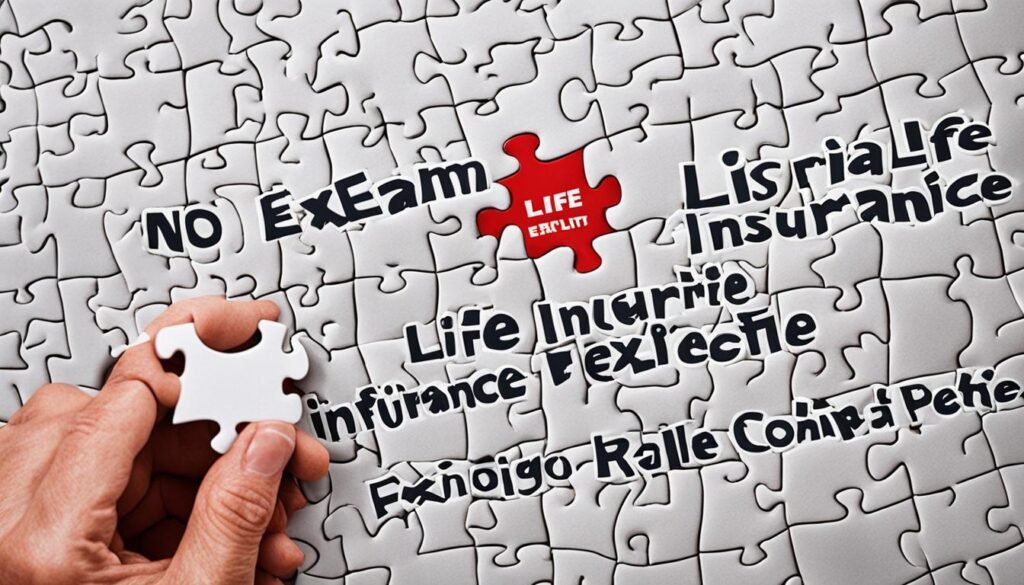Having a life insurance for pre-existing conditions can impact your ability to get life insurance and may result in higher costs and limited coverage options. A pre-existing condition refers to a medical issue that you were diagnosed with or treated for before applying for life insurance. Insurance companies categorize applicants into different risk classes based on their health, and those with serious health conditions may be offered substandard rates or even denied coverage entirely. However, there are still options available, such as guaranteed issue life insurance or policies offered by specific companies that cater to individuals with certain medical conditions.
Key Takeaways:
- Having a pre-existing condition can impact your ability to get life insurance and may result in higher costs and limited coverage options.
- Insurance companies categorize applicants into different risk classes based on their health, and those with serious health conditions may be offered substandard rates or even denied coverage entirely.
- There are still options available, such as guaranteed issue life insurance or policies offered by specific companies that cater to individuals with certain medical conditions.
- It is important to explore different life insurance options and work with knowledgeable insurance agents who specialize in high-risk cases.
- Being honest and transparent about pre-existing conditions when applying for coverage is essential.
What is a pre-existing condition?
A pre-existing condition refers to a medical issue that you have been diagnosed with or received treatment for before applying for life insurance. It’s important to note that each insurance company has its own underwriting process, and the impact of a pre-existing condition can vary. Common pre-existing conditions include cancer, diabetes, high blood pressure, asthma, and heart disease. When assessing the risk of insuring individuals with pre-existing conditions, insurance companies consider factors such as the severity of the condition, current health status, treatment history, and overall medical history. In some cases, a medical exam may be required to evaluate the applicant’s health.
Managing pre-existing conditions can be challenging, but with the right knowledge and support, it’s possible to find the life insurance coverage you need. Understanding how insurance companies evaluate pre-existing conditions and being transparent about your medical history during the application process is crucial for obtaining appropriate coverage.
How much does life insurance with a pre-existing condition cost?
The cost of life insurance with a pre-existing condition can vary depending on the severity of the condition and the insurer’s assessment of the associated risk. Insurance companies typically group applicants into different rate classes based on their overall health. Applicants with pre-existing conditions may be classified as substandard and offered higher premium rates due to the increased risk of early or unexpected death.
However, advancements in medical treatments and improved health outcomes may lead to more favorable rates for individuals in remission or those with well-managed chronic conditions.
Life Insurance Options for People with Pre-Existing Conditions
Despite having a pre-existing condition, there are still life insurance options available to provide coverage and peace of mind. Insurance companies recognize the unique needs of individuals with specific medical conditions and offer tailored policies to cater to their requirements.
Specialized Policies for Specific Medical Conditions
Some insurance companies, such as Guardian Life and John Hancock, offer specialized policies for individuals with certain medical conditions. For instance, Guardian Life provides whole life insurance specifically designed for people living with HIV, ensuring comprehensive coverage for their unique needs. John Hancock offers a policy tailored for those with Type 1 or Type 2 diabetes, taking into account the management and control of their condition.
“Guardian Life provides whole life insurance specifically designed for people living with HIV, ensuring comprehensive coverage for their unique needs.”
Guaranteed Issue Life Insurance
Guaranteed issue life insurance is an option for individuals with pre-existing conditions who may be concerned about the acceptance process. These policies guarantee acceptance within a certain age range without requiring a medical exam or health questionnaire. They provide a viable solution for those who may have difficulty obtaining coverage through traditional underwriting processes.
Group Life Insurance
Another option for individuals with pre-existing conditions is group life insurance through their employer. This type of coverage often provides basic insurance without the need for a medical examination. Group life insurance can offer peace of mind for employees, ensuring that their loved ones will be protected financially in the event of their passing.
Here is a comparison table highlighting the key features of these different life insurance options for people with pre-existing conditions:
| Insurance Provider | Specialized Policies | Guaranteed Issue Life Insurance | Group Life Insurance |
|---|---|---|---|
| Guardian Life | Whole life insurance for individuals with HIV | No | No |
| John Hancock | Policy tailored for individuals with Type 1 or Type 2 diabetes | No | No |
| Other Insurance Companies | No | Yes | Yes |
“Guaranteed issue life insurance is an option for individuals with pre-existing conditions who may be concerned about the acceptance process.”
Remember to research and consult with insurance professionals to determine the best life insurance option for your specific pre-existing condition. With the right policy in place, you can ensure that financial protection and security are provided for your loved ones, even in the face of health challenges.
Tips for Buying Life Insurance with a Pre-Existing Condition
When applying for life insurance with a pre-existing condition, it’s crucial to follow certain tips to ensure you find the best coverage for your needs. Here are some key considerations:
- Apply for coverage early: Rates are generally more affordable when you are younger and in better overall health.
- Work with an insurance agent: Choose an agent who specializes in impaired risk cases and can guide you through the process of finding suitable coverage options.
- Be honest and transparent: Disclose your health condition truthfully on the application to avoid potential denial of claims in the future.
- Complete a health questionnaire: Some insurers may require you to fill out a health questionnaire, providing detailed information about your pre-existing condition and medical history.
- Obtain multiple life insurance quotes: Shop around and compare quotes from different insurers to find the most competitive rates and coverage.
- Focus on maintaining overall good health: By taking proactive steps to improve your overall health, such as managing your pre-existing condition, you may qualify for better premium rates in the future.
By following these tips, you can navigate the process of buying life insurance with a pre-existing condition and secure coverage that meets your specific needs.
Can you get life insurance with a pre-existing condition?
Yes, it is possible to get life insurance with a pre-existing condition. Despite the challenges associated with obtaining coverage, there are options available to ensure financial security for individuals with health conditions. Three common types of life insurance that cater to those with pre-existing conditions are: no-exam life insurance, term life insurance, and group life insurance.
No-Exam Life Insurance
No-exam life insurance is designed specifically for individuals who may be denied coverage due to their health condition. This type of policy does not require a medical exam, making it more accessible and convenient. Instead of relying on medical underwriting, insurers assess the risk based on the applicant’s age, gender, and answers provided in a health questionnaire. No-exam life insurance provides an opportunity for individuals with pre-existing conditions to secure coverage without the need for extensive medical evaluations.
Term Life Insurance
Term life insurance offers coverage for a specific period of time, typically 10, 20, or 30 years. While it may require a medical exam, individuals with controlled or well-managed pre-existing conditions can still qualify for this type of coverage. Term life insurance is often more affordable compared to other types of policies, making it an attractive choice for individuals seeking financial protection during specific stages of their lives.
Group Life Insurance
Group life insurance is a policy provided by employers to their employees as part of a benefits package. This type of coverage offers basic protection without requiring a medical exam. Group life insurance is a viable option for individuals with pre-existing conditions who are currently employed. However, it’s important to note that coverage through group life insurance is typically limited and may not be sufficient for everyone’s individual needs.
It’s worth mentioning that the availability and cost of life insurance coverage for individuals with pre-existing conditions depend on the severity of the condition. While some conditions may still make it challenging to obtain coverage, exploring the options mentioned above increases the chances of finding a suitable policy.

How do pre-existing conditions impact life insurance rates?
When it comes to determining life insurance rates, pre-existing conditions play a significant role. Insurance companies consider various factors, including the severity of the medical condition, the date of diagnosis, how the condition is managed, and an individual’s lifestyle. These factors help insurers assess the risk associated with covering a person and classify them into different risk categories.
Insurance companies typically use a tiered system that includes classifications such as super preferred, preferred, standard, and substandard. The severity of the life insurance companies pre-existing condition and the level of risk it poses increase the likelihood of being placed in a lower-tier classification, resulting in higher premium rates.
However, it’s important to note that certain factors can influence the risk classification and potentially lead to lower premiums. For instance, improvements in the condition’s severity, a stable medical history, and healthier lifestyle choices can have a positive impact on the risk assessment. These factors may result in a more favorable risk classification and lower life insurance premiums.
Impact of Severity of Medical Condition
The severity of a pre-existing medical condition directly affects life insurance rates. Conditions that have more severe implications and higher mortality risks generally lead to higher premiums. Insurance companies evaluate the severity based on factors such as the prognosis, treatment options, and overall impact on an individual’s health and well-being.
Impact of Date of Diagnosis
The date of diagnosis is another crucial factor in determining life insurance rates. Insurance companies analyze both the recentness of the diagnosis and the stability of the condition. If a diagnosis occurred a long time ago and health problems the condition has life policy not worsened significantly, it may have a lesser impact on the premium rates. On the other hand, recent diagnoses or conditions that are rapidly progressing may result in higher premiums.
Impact of How the Condition is Managed
The management of a pre-existing condition plays a vital role in life insurance rates. Insurance companies assess how well an individual is managing their condition through regular medical check-ups, adherence to treatment plans, and lifestyle modifications. Individuals who actively manage their condition and demonstrate good control may be eligible for lower premium rates.
Impact of Lifestyle
Lifestyle choices also influence life insurance rates for individuals with pre-existing conditions. Factors such as smoking, alcohol consumption, weight management, and physical activity levels are evaluated by insurance companies. Maintaining a healthy lifestyle and making positive choices can potentially lead to more affordable premiums.
| Factors | Impact on Life Insurance Rates |
|---|---|
| Severity of Medical Condition | Higher severity may lead to higher rates |
| Date of Diagnosis | Recent or rapidly progressing conditions may lead to higher rates |
| How the Condition is Managed | Active management and stability may result in lower rates |
| Lifestyle | Healthy lifestyle choices may contribute to more affordable premiums |
It’s important to understand that each insurance company has its own underwriting guidelines and may prioritize different factors when determining life insurance rates for individuals with pre-existing conditions. Consulting with an insurance agent who specializes in high-risk cases can provide valuable guidance and help find the most suitable coverage options.

What Kind of Life Insurance Can You Get with a Pre-Existing Condition?
Individuals with a pre-existing condition have several options for obtaining life insurance coverage. These options cater to different needs and circumstances, ensuring that individuals with pre-existing conditions can still protect their loved ones financially. Let’s explore the different types of life insurance policies available:
1. Guaranteed Issue Life Insurance
Guaranteed issue life insurance is a type of policy that guarantees acceptance within a certain age range, typically between 50 and 80 years old. This option is particularly beneficial for individuals with pre-existing conditions who may be denied coverage by traditional insurance companies. With guaranteed issue life insurance, there is no requirement for a medical exam or health questionnaire, making it easier to obtain coverage. However, it’s important to note that these policies may have lower coverage amounts and higher premiums compared to other types of life insurance.
2. Term Life Insurance
Term life insurance provides coverage for a specific period of time, usually 10, 20, or 30 years. This option can be more affordable than other types of insurance, making it a viable choice for individuals with pre-existing conditions. However, it’s essential to consider the duration of coverage carefully. If your pre-existing condition is likely to persist beyond the term of the policy, you may need to explore other options. Additionally, some insurance companies may require medical underwriting for term life insurance, meaning they will assess your health condition before offering coverage.
3. Group Life Insurance
Group life insurance is a policy offered through an employer or an organization. This option provides basic coverage without the requirement of a medical exam. Group life insurance is typically more accessible and affordable than individual policies, making it an attractive choice for individuals with pre-existing conditions. However, the coverage amount may be limited, and it’s important to understand the terms and conditions of the policy, as coverage may end if you leave the group or employer.
Also Read:- Maximizing Your Assets With Universal Whole Life Insurance
Each type of life insurance policy offers unique benefits and considerations, so it’s crucial to assess your specific needs and consult with an insurance professional to determine the most suitable option for you.

Additional Tips for Buying Life Insurance with a Pre-Existing Condition
In addition to the previous tips mentioned, there are a few more considerations when buying life insurance with a pre-existing condition.
Firstly, it’s important to maintain open communication with your insurer. If there have been improvements in your health condition, make sure to inform the insurer. This information can potentially lead to adjustments in your premium rates, making coverage more affordable.
Secondly, working with an experienced insurance agent who specializes in high-risk cases is crucial. An insurance agent can guide you through the entire process, ensuring that you find the best coverage options for your specific needs.
Furthermore, be prepared to undergo a medical screening or provide evidence of improvement from a medical professional. This step helps to validate any progress in your health and may positively impact your insurance application.
By taking these additional steps, you can increase your chances of finding affordable coverage that meets your specific needs, even with a pre-existing condition.
What to do if you’ve been denied life insurance
If you have been denied life insurance or cannot find affordable premiums due to a pre-existing condition, don’t lose hope. There are options to explore that can help you secure the coverage you need or provide alternative ways to protect your loved ones financially.
Reapply for Life Insurance
If your pre-existing condition has improved or stabilized, you can consider reapplying for life insurance. Insurance carriers may have specific timelines or waiting periods before you can reapply. It’s important to work with an experienced insurance agent who can guide you through the process and help you find companies that are more receptive to your situation.
Investment Options
Alternatively, if obtaining life insurance coverage is still challenging, you can explore investment options as an alternative way to leave money to your beneficiaries. By investing the money you would have paid in premiums into a well-managed investment account, you can potentially build a substantial financial asset that can be passed on to your loved ones.
Remember to consult with financial advisors who can provide personalized advice based on your specific circumstances. They can help you navigate the complexities of investments and determine the most suitable option for your financial goals.
Although being denied life insurance can be disheartening, it’s essential to explore all available options and seek professional guidance. Whether you choose to reapply for life insurance or pursue investment alternatives, taking proactive steps will help you ensure the financial security of your loved ones.
Conclusion
Life insurance coverage is accessible for individuals with pre-existing conditions, although it may require careful consideration and research. There are various life insurance options available that cater to individuals with specific medical conditions. By exploring options such as guaranteed issue policies, term life insurance, and group life insurance, individuals can find coverage that suits their needs.
Honesty and transparency are crucial when applying for life insurance with a pre-existing condition. It is important to disclose all relevant information about your health condition to the insurer to ensure accurate risk assessment. Working with knowledgeable insurance agents who specialize in high-risk cases can provide valuable guidance throughout the process of buying life insurance.
With proper planning and understanding of the available options, individuals with pre-existing conditions can secure affordable and comprehensive life insurance coverage. By exploring different policies, comparing premiums, and considering improvements in their overall health, individuals can find suitable coverage that provides financial security for their loved ones.
FAQs
Q: What is a pre-existing condition?
A: A pre-existing condition is a medical issue that you have been diagnosed with or received treatment for prior to applying for life insurance.
Q: How much does life insurance with a pre-existing condition cost?
A: The cost of life insurance with a pre-existing condition can vary depending on the severity of the condition and the insurer’s assessment of the associated risk.
Q: What are the options for life insurance with a pre-existing condition?
A: Options for life insurance with a pre-existing condition include guaranteed issue life insurance, term life insurance, and group life insurance through an employer.
Q: What are some tips for buying life insurance with a pre-existing condition?
A: Tips for buying life insurance with a pre-existing condition include working with an insurance agent, completing a health questionnaire, and obtaining multiple life insurance quotes.
Q: Can you get life insurance with a pre-existing condition?
A: Yes, it is possible to get life insurance with a pre-existing condition. Options include no-exam life insurance, term life insurance, and group life insurance through an employer.
Q: How do pre-existing conditions impact life insurance rates?
A: Pre-existing conditions can impact life insurance rates based on factors such as the severity of the medical condition, the date of diagnosis, how the condition is managed, and the individual’s lifestyle.
Q: What kind of life insurance can you get with a pre-existing condition?
A: With a pre-existing condition, you can obtain guaranteed issue life insurance, term life insurance, or group life insurance through an employer.
Q: What are some additional tips for buying life insurance with a pre-existing condition?
A: Additional tips for buying life insurance with a pre-existing condition include communicating improvements in your health to the insurer, working with an experienced insurance agent, and being prepared to undergo a medical screening.
Q: What should you do if you’ve been denied life insurance?
A: If you’ve been denied life insurance, you can consider reapplying once your condition has improved or explore investment options as an alternative way to leave money to your beneficiaries.
Q: Is life insurance coverage available for individuals with pre-existing conditions?
A: Yes, life insurance coverage is available for individuals with pre-existing conditions. By exploring different options and working with knowledgeable insurance agents, individuals can find affordable and comprehensive coverage.
Q: What is a pre-existing medical condition in the context of life insurance?
A: A pre-existing medical condition is a health issue that an individual has before applying for a new health insurance policy.
Q: How do pre-existing conditions affect life insurance coverage?
A: Pre-existing conditions can impact the availability and cost of life insurance coverage, as insurance companies consider the associated health risks when determining premiums and coverage options.
Q: Can I still get life insurance with a pre-existing condition?
A: Yes, it is possible to obtain life insurance with a pre-existing condition, although it may require specialized or guaranteed issue policies that cater to individuals with health issues.
Q: What types of life insurance are available for individuals with pre-existing conditions?
A: Individuals with pre-existing conditions may consider guaranteed issue whole life insurance, which provides coverage without the need for a medical exam or detailed health history.
Q: How does a pre-existing condition impact the application process for life insurance?
A: A pre-existing condition may require additional documentation or information during the life insurance application process, and it can affect the approval and terms of the policy.
Q: What steps can I take to find affordable life insurance with a pre-existing condition?
A: It is advisable to compare quotes from multiple life insurance providers, consider specialized policies, and consult with insurance agents specializing in pre-existing conditions to find affordable coverage.
Q: Are there specific life insurance providers that specialize in coverage for pre-existing conditions?
A: Yes, there are insurance companies that offer specific policies catering to individuals with pre-existing health conditions, providing tailored coverage options.
Q: How do insurance companies assess the overall health of individuals with pre-existing conditions?
A: Insurance companies evaluate the overall health and life expectancy of individuals with pre-existing conditions based on medical history, current health status, and the specific health condition in question.
Q: What are some common health conditions that are considered pre-existing conditions for life insurance?
A: Common health conditions that may be considered pre-existing for life insurance include high blood pressure, diabetes, heart disease, cancer, and other chronic or serious health conditions.
Q: Can having a pre-existing condition impact the type of life insurance policy available?
A: Yes, having a pre-existing condition can influence the types of life insurance policies available, potentially leading to limitations on coverage options or premium variations based on health risk assessments.




